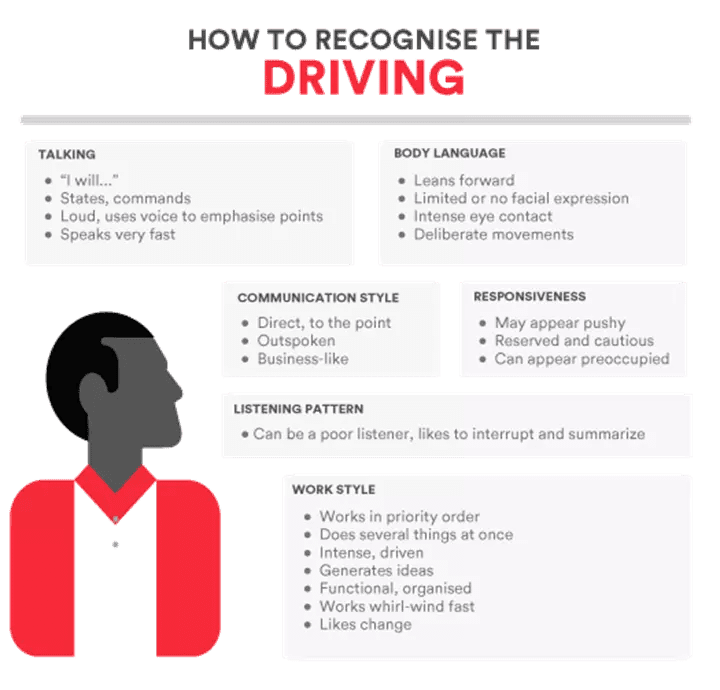
What is the Driving Personality Type?
The Driving Social Personality Type is High in Assertiveness and Low in Responsiveness. They are Logical, Result-oriented, Competitive, Fast-paced, and Decisive.
Driver Personality Type Cross-reference
- Keirsey Type – Rationals
- Temperament Type – Choleric
- Animal Type – Lion
- DISC Type – Dominant
- True Colors – Green
- Color Code – Red
- Personality Compass – North
- Occupational Type – Enterprising
- Learning Type – Activist
- Leadership Type – Dominator
MBTI Personality Types (xNTx) – Intuition and Thinking
Enneagram Types
- Type 1 – The Reformer (ENTJ, INTJ)
- Type 3 – The Achiever (ENTP)
- Type 5 – The Investigator (INTJ, INTP)
- Type 7 – The Enthusiast (ENTP)
- Type 8 – The Challenger (ENTJ)
What are the 4 Social Personality Types?
There are four behavioral-focused Social Personality Types based on your level of Assertiveness and Responsiveness. It’s your personality that’s on display!
In the early 1960s, two industrial psychologists, David Merrill and Roger Reid, wanted to understand whether they could predict managerial, leadership, and sales performance. To do this, they explored how people behaved in social situations and chose not to concern themselves with why.
Merrill and Reid started with BF Skinner’s ideas of behaviorism and James Taylor’s structured list of behavioral descriptions, and they discovered that people’s behavior follows along two continua, which they labeled Assertiveness and Responsiveness.
Assertiveness Style
The Assertiveness Style ranges from asking behaviors to telling behaviors, while the Responsiveness Style varies from emoting or displaying our feelings to controlling our emotions.
Assertive people can initiate, maintain, and terminate conversations skillfully. They are competitive, dominant, forceful, and independent.
Responsiveness Style
Responsive people are others-oriented, meaning they listen to others and show a general concern for their success. They are helpful, compassionate, friendly, sincere, and considerate of others’ feelings.
An individual’s level of Assertiveness and Responsiveness determines their Social Style.

Learn more about the 4 Social Personality Types.
The Driving Personality Type
Traits
- Logical
- Result-oriented
- Competitive
- Fast-paced
- Decisive
Motivation
- Control
- Authority
- The need to win
Under-stress
- May become overly critical and autocratic
Driver Type Communication Styles
- Try to be efficient and support their conclusion and actions.
- Try to provide concise, precise, and organized information.
- Stay focused on the goals, objectives, tasks, and results.
- Be prepared to answer “What” questions.
When the Driver communicates with an Analytical
Relate to your efficiency, logic, command of data, and task orientation.
Question your haste, decisiveness, competitiveness, and risk-taking.
- Bring detailed facts and logic in writing.
- Be patient while they evaluate and check the accuracy of the data.
- Help them reach conclusions by encouraging them to set deadlines after you have provided time for review.
When the Driver communicates with an Amiable
Relate to your efficiency and discipline.
Question your lack of feeling, tough-mindedness, bottom-line orientation, impatience, and
secretiveness.
Working with this Style will require you to exercise your versatility.
- Show concern for them and their interests.
- Slow down and provide details and specifics about how to accomplish objectives.
- Support efforts and accomplishments with personal attention.
When the Driver communicates with an Expressive
Relate to your actions, independence, and decisiveness.
Question your coldness, lack of playfulness, critical nature, and discipline.
- Be more open about yourself, your feelings, and your opinions.
- Relax time constraints within the structure; provide incentives.
- Provide public recognition for accomplishments (let them win in front of
- others).
When the Driver communicates with another Driver
Perceive you as action-oriented, in a hurry, commanding, efficient, stubborn, disciplined, inflexible, independent, secretive, logical, demanding, non-listening, quick, decisive, and unfeeling.
Agree on specific goals and provide freedom to work within these limits.
An unproductive deadlock can occur when there is too much dominance and no allowance for independence and individuality.
Driver Type Action Plan
| Driver Characteristics | So You |
|---|---|
| They like being #1. | Show them how to win new opportunities. |
| They think logically. | Display reasoning. |
| They want facts and highlights. | Provide concise data. |
| They strive for results. | Agree on goals and boundaries, then support or get out of their way. |
| They like personal choices. | Allow them to do their thing within limits. |
| They like changes. | Vary routine. |
| They prefer to delegate. | Look for opportunities to modify their workload focus. |
| They want others to notice their accomplishments. | Compliment them on what they’ve done. |
| They need to be in charge. | Let them take the lead when appropriate, but give them parameters. |
| They tend to conflict. | If necessary, argue with conviction on points of disagreement, backed up with facts; don’t argue on a personality basis. |
Portrait of a Driver’s Office
Of course, it must be the corner office with two windows, but the Driver never looks at the view.
Pictures on the wall are of battlefields, maps, and boats.
The Driver is multi-tasked and can simultaneously sign letters, hold interviews, and talk on the phone.
Office furniture contributes to the impression of power and control and is the most expensive and incredibly available.
The office may also contain flowers and plants, even exotic ones like orchids (carefully chosen to contribute to the impression of power), but the Driver never looks after them.
On the desk are often family portraits but never candid shots. Instead, they are formal portraits showing everyone in their proper role, frozen forever as the Driver sees them.
An interior designer will probably decorate the office with intense colors to create a feeling of power.
Curt is tough, straight to business. That’s the Driver at work in their den. Don’t waste time. Get straight to the point!

